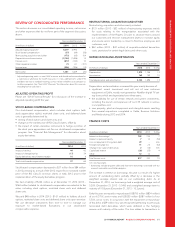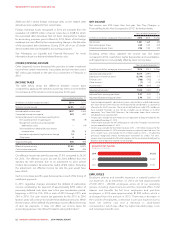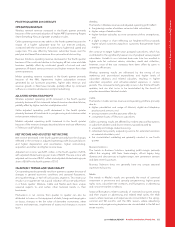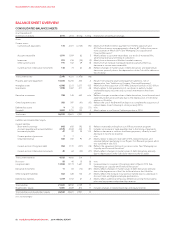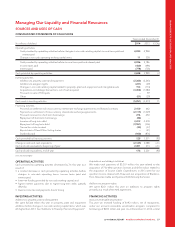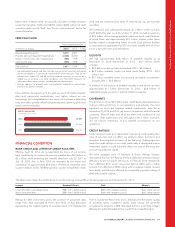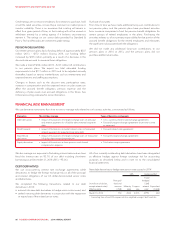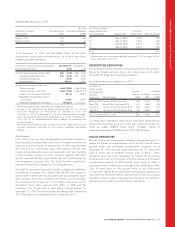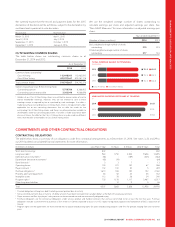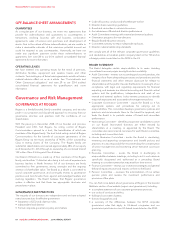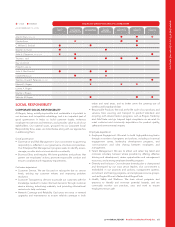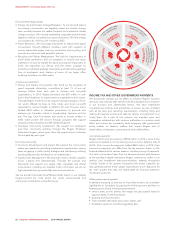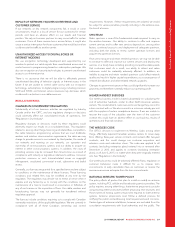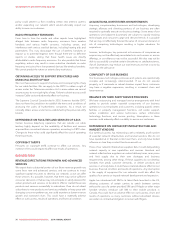Rogers 2014 Annual Report Download - page 64
Download and view the complete annual report
Please find page 64 of the 2014 Rogers annual report below. You can navigate through the pages in the report by either clicking on the pages listed below, or by using the keyword search tool below to find specific information within the annual report.
MANAGEMENT’S DISCUSSION AND ANALYSIS
Credit ratings are not recommendations for investors to purchase, hold
or sell the rated securities, nor are they a comment on market price or
investor suitability. There is no assurance that a rating will remain in
effect for a given period of time, or that a rating will not be revised or
withdrawn entirely by a rating agency if it believes circumstances
warrant it. The ratings on our senior debt provided by Standard &
Poor’s, Fitch and Moody’s are investment grade ratings.
PENSION OBLIGATIONS
Our retiree pension plans had a funding deficit of approximately $307
million (2013 – $172 million). During 2014, our funding deficit
increased by $135 million primarily as a result of a decrease in the
discount rate we used to measure these obligations.
We made a total of $106 million (2013 – $101 million) of contributions
to our pension plans. We expect our total estimated funding
requirements to be $117 million in 2015 and to be adjusted annually
thereafter, based on various market factors such as interest rates and
expected returns and staffing assumptions.
Changes in factors such as the discount rate, participation rates,
increase in compensation and the expected return on plan assets can
affect the accrued benefit obligation, pension expense and the
deficiency of plan assets over accrued obligations in the future. See
Critical accounting estimates for more information.
Purchase of annuities
From time to time we have made additional lump-sum contributions to
our pension plans, and the pension plans have purchased annuities
from insurance companies to fund the pension benefit obligations for
certain groups of retired employees in the plans. Purchasing the
annuities relieves us of our primary responsibility for that portion of the
accrued benefit obligations for the retiredemployeesandeliminates
the significant risk associated with the obligations.
We did not make any additional lump-sum contributions to our
pension plans in 2014 or 2013, and the pension plans did not
purchase additional annuities.
FINANCIAL RISK MANAGEMENT
We use derivative instruments from time to time to manage risks related to our business activities, summarized as follows:
Derivative The risk they manage Types of derivative instruments
Debt derivatives • Impact of fluctuations in foreign exchange rates on principal
and interest payments for US dollar-denominated long-term
debt
• Cross-currency interest rate exchange agreements
• Forward foreign exchange agreements (from time to time
as necessary)
Bond forwards • Impact of fluctuations in market interest rates on forecasted
interest payments for expected long-term debt
• Forward interest rate agreements
Expenditure
derivatives
• Impact of fluctuations in foreign exchange rates on forecasted
US dollar-denominated expenditures
• Forward foreign exchange agreements
Equity derivatives • Impact of fluctuations in share price on stock-based
compensation expense
• Total return swap agreements
We also manage our exposure to fluctuating interest rates and we have
fixed the interest rate on 92.7% of our debt including short-term
borrowings as at December 31, 2014 (2013 – 95.3%).
DEBT DERIVATIVES
We use cross-currency interest rate exchange agreements (debt
derivatives), to hedge the foreign exchange risk on all of the principal
and interest obligations of our US dollar-denominated senior notes
and debentures.
We completed the following transactions related to our debt
derivatives in 2014:
• entered into new debt derivatives to hedge senior notes issued; and
• settled maturing debt derivatives in conjunction with the repayment
or repurchase of the related senior notes.
All of our currently outstanding debt derivatives have been designated
as effective hedges against foreign exchange risk for accounting
purposes as described below and in note 16 to the consolidated
financial statements.
New debt derivatives to hedge new senior notes issued in 2014
(In millions of dollars,
except interest rates)
Effective date
US$ Hedging effect
Principal/
Notional
amount
(US$)
Maturity
date
Coupon
rate
Fixed
hedged
Cdn$
interest
rate 1
Equivalent
(Cdn$)
March 10, 2014 750 2044 5.00% 4.99% 832
1Converting from a fixed US$ coupon rate to a weighted average Cdn$ fixed rate.
60 ROGERS COMMUNICATIONS INC. 2014 ANNUAL REPORT



